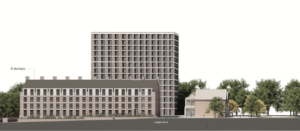
Threat to Oakley, the Victorian villa on Wilmslow Road in Fallowfield
Manchester Civic Society has strongly objected to proposals (Application 129020/FO/2020) to intensively develop the spacious grounds of Oakley, the Victorian villa at the southern edge of Platt Fields.
Oakley’s setting is an integral part of the historic and social value of the villa, whose generous gardens retain open space on the north and west of its site, where the boundaries are shared with Platt Fields.
Two large student residence blocks would be built to house 440 students. One block is a 13 storey tower, the other an L-shaped block of 4 to 5 storeys in height. Much of the site of Oakley’s western garden area will be built over, to the boundaries, to achieve this density.
Oakley itself was described by the famous architectural historian, Sir Nikolaus Pevsner, as ‘a large early c19 Gothic house in its own grounds, one of the only survivors of a number of large, detached villas of this date in the area.’ The house, built around 1837 is interesting in part because its style is an atypical example of an early-to-mid 19 th Century residential villa.
Although not listed, Oakley is recognised to be a non-designated heritage asset. This gives it protections. Its conservation, and that of its setting, are both objectives of the National Planning Policy Framework and are material considerations when determining the outcome of a planning application. They require that Oakley and its setting should be conserved and enhanced.
This development will inflict harm well beyond Oakley, as below;
1. The dominant 13 storey tower is totally out of keeping with the area’s character and appearance. The spire of Holy Trinity Church, at the opposite end of Platt Fields, is the tallest structure next to the park; the nearby ‘Toast Rack’, is a mere 7 storeys in height.
2. The proposals will inflict loss and damage to the green environment of Fallowfield, its wildlife and wildlife corridors. Construction work close to the Platt Fields boundary will destroy mature sycamores in the park.
3. The ambience of Platt Fields will also be heavily compromised by the light and noise inevitable from a 13 storey residential block on its edge and by the inevitable recreatonal use of Platt Fields by a substantial proportion of the student residents and their friends.
4. The immediate neighbourhood and its residents will be badly affected.
- The L-shaped 4-5 storey structure will dominate, at close distance, the modest Victorian terraced houses on adjacent roads to the south of Oakley.
- Housing 440 students here will inevitably create overspill harms, including for residents. These harms include parking, noise and light pollution.
5. The student population here is already dominant one, at 56% of the resident population.
6. The site falls outside those areas which Manchester City Council has identified as acceptable for building more student accommodation.
This proposal to site buildings of such massing and density in this area, and in the grounds of a recognised heritage asset, conflicts with several of the Council’s Policies. In December 2020, the Council Executive requested that Planning should consider only a limited set of locations for new-build student accommodation. This area, in which 56% of the population are already students was not one of them.
We have asked for this proposal to be referred back for a radical rethink.
